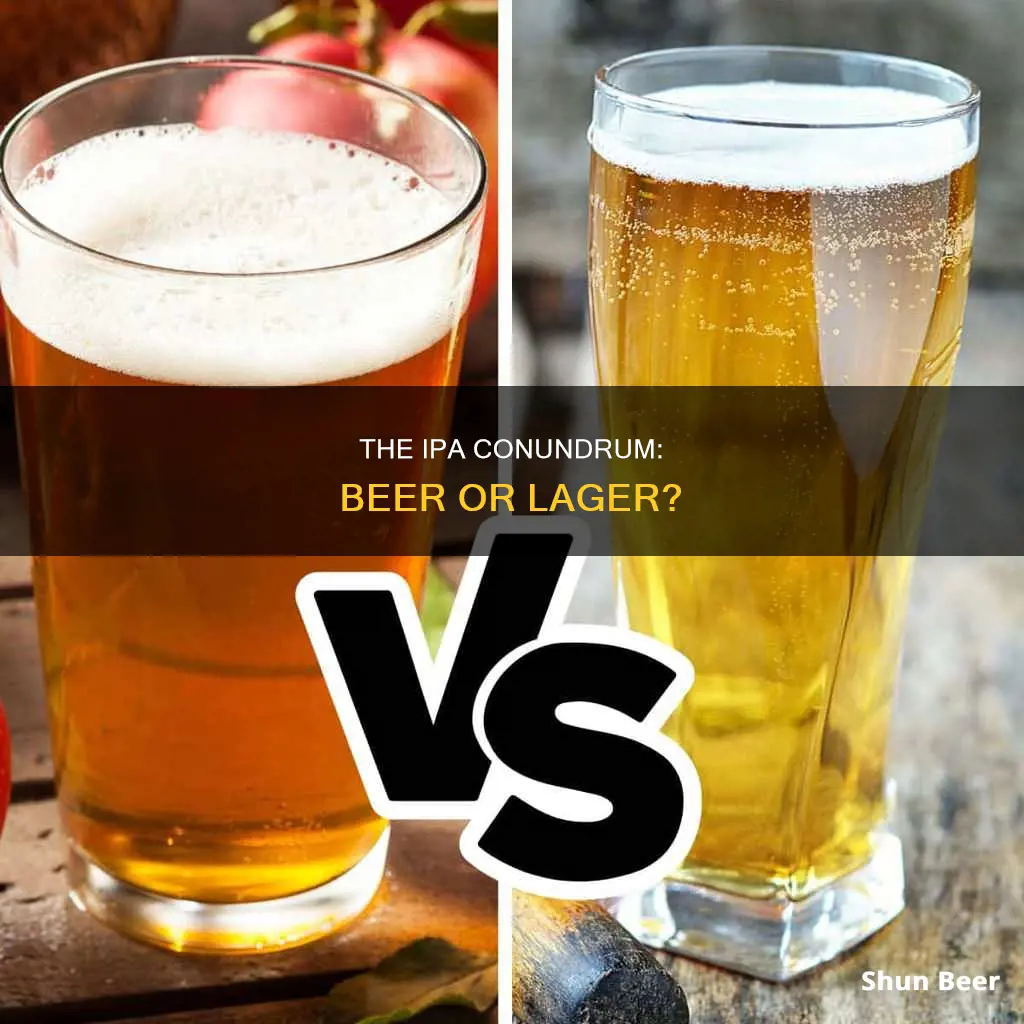
Beer is made up of a combination of water, grain, yeast, and hops. The two main types of beer are lager and ale, differentiated by how they are made, specifically the temperature conditions of fermentation. Lager is the most common style of beer. Its name comes from the German word lagern, meaning to store. Lagers are made with bottom-fermenting yeast and are left in cooler temperatures for weeks while the fermentation process takes place. Ales, on the other hand, are brewed with top-fermenting yeast. Fermentation takes place in warm temperatures, which speeds up the process. IPAs, or India Pale Ales, are a subcategory of ales. They were invented by a London-based brewer in the 1780s to survive the voyage to India. IPAs are known for their high bitterness, achieved through the use of aromatic hops.
| Characteristics | Values |
|---|---|
| Type | IPA is a style of ale |
| Fermentation | Ales are fermented at higher temperatures than lagers |
| Flavour | IPAs tend to be citrusy, bitter and piney in flavour |
| Alcohol content | IPAs are supposed to be high in alcohol content |
| Serving temperature | Ales are served warmer than lagers |
What You'll Learn

IPAs are a type of ale
IPAs, or India Pale Ales, are a type of ale. They were first created in the 1780s by British brewer George Hodgson, who added extra hops and increased the alcohol content to help his beer survive the long voyage to India. This also gave the beer a more bitter taste, which has become a defining characteristic of IPAs.
IPAs are brewed with top-fermenting yeast, which rises to the top during fermentation, resulting in a thick layer of foam. They are fermented at a higher temperature than lagers, typically between 57-68°F (14-20°C). The warmer fermentation temperature also means that ales don't need to be stored for long periods of time.
The flavour of an IPA tends to be more complex and fruity compared to lagers, and they often have higher alcohol content. They pair well with spicy, salty, and grilled foods.
There are several styles of IPAs, including American, English, West Coast, East Coast, session IPAs, hazy IPAs, dark IPAs, and double or triple IPAs.
Stout Beer Basics: Guinness Extra Stout's Dark Side
You may want to see also

Lager is the most common style of beer
Lagers are made with bottom-fermenting yeast, which sinks to the bottom of the brewing vat during the fermentation process. This is in contrast to ales, which are brewed with top-fermenting yeast that rises to the top. Lagers are left in cooler temperatures for weeks while the fermentation process takes place, and then stored again at cold temperatures to condition them. This process is known as "lagering".
Lagers have a light, crisp taste and a smooth, well-balanced flavour. They are often less bitter than other styles of beer and are known for their uncomplicated, easy-drinking qualities. This makes them a popular choice for casual drinking, especially in the summer. Many of the most common brands of beer, such as Heineken, Sapporo, Budweiser, Coors Light, and Bud Light, can be classified as lagers.
Lagers come in a range of colours, from pale to amber to dark brown and black. The depth of colour comes from the specific grain bill used in the beers. Pale lagers are the most widely consumed and commercially available style, and they have a mild flavour. Amber lagers, such as Märzen and Bock, are generally darker in colour than pale lagers, often with a deep tan or amber hue. Dark lagers, such as Dunkel and Schwarzbier, use roasted grains and malts to produce a more roasted, slightly burnt flavour profile.
Skull IPA Beer: Registered in New York?
You may want to see also

Ales are the oldest style of beer
Ale is brewed using a warm fermentation method, typically between 68 and 72 degrees Fahrenheit. This is done using top-fermenting yeast, which rises to the top during fermentation, resulting in a thick layer of foam. The warm fermentation temperature speeds up the brewing process, so ales don't need to be stored for long periods.
The flavour of ale tends to be more complex and fruity compared to lager. Ales are often described as having a sweeter, maltier taste. They pair well with burgers, Asian food, and pizza.
There are many different styles of ales, including but not limited to:
- Bitter Ales
- Pale Ales
- Brown Ales
- Porter
- Scotch Ale
- Stout
- Belgian Ales
- Trappist Ales
- Kolsch
- Weisse
- Weizenbier
- Amber Ale
- Sour Ale
- Irish Red Ale
- Altbier
- Berliner Weisse
- Hefeweizen
Ales are distinct from lagers, the other major classification of beers. Lagers are made with bottom-fermenting yeast and are left in cooler temperatures for weeks during the fermentation process. They tend to have a lighter, crisper taste and are often less bitter than ales.
Guinness Beer: A Domestic or Foreign Affair?
You may want to see also

Lager is German for larder or storehouse
Lager is the most common style of beer. The name is derived from the German word "lagern", which means "to store". Lager is also the German word for "larder" or "storehouse". It is called this because the beer was traditionally stored before drinking, often in the same cool caves where it was fermented.
Lager is brewed and conditioned at low temperatures, and can be pale, amber, or dark. Pale lager is the most widely consumed and commercially available style. The German word "Lagerbier" referred to all types of bottom-fermented, cool-conditioned beer in normal strengths. Today, it mainly refers to beers from southern Germany, either "Helles" (pale) or "Dunkles" (dark).
Lager is made with bottom-fermenting yeast, which ferments at relatively cold temperatures. It is left in cooler temperatures (45-55 degrees Fahrenheit) for weeks while the fermentation process takes place. This is in contrast to ales, which are brewed with top-fermenting yeast and fermented at warmer temperatures (68-72 degrees Fahrenheit).
Lagers tend to have a light, crisp taste and a smooth, well-balanced flavor. They are often less bitter than other styles of beer and are comparable to white wine. Pilsners and malt liquor are different styles within the lager category. Many common brands of beer, such as Heineken, Sapporo, and Budweiser, can be classified as lagers.
Lagers pair well with a variety of foods, including shellfish, grilled chicken or pork, and Mexican cuisine. Their lighter flavor and paler styles make them versatile when it comes to food pairings.
The rise of lager was closely linked to the development of refrigeration, as it allowed lager to be brewed year-round. It also made it possible to brew lager in more places and keep it cold until serving.
Stout and IPA: What's the Difference?
You may want to see also

IPAs are often described as bitter
IPAs, or India Pale Ales, are often described as bitter. This distinct bitter taste is due to the hops used in the brewing process. Hops are the flowers of the female plant Humulus lupulus, a member of the hemp family. Hops counteract the sweetness of malt grain and have been added to beer since 822 AD.
The more hops are added, the more bitter the beer will be. The timing of when the hops are added to the mixture during the brewing process also affects the bitterness of the IPA. The earlier the hops are added, the more bitter the beer will be. The type of hops used also determines the bitterness profile of the beer. There are over 100 types of hops, and each offers a different flavour.
The bitterness of IPAs can be measured using the International Bitterness Units (IBUs) scale. This scale generally ranges from 1 to 100, with beers going up to 1,000 IBUs. Beers with an IBU of over 45 are considered to be more on the bitter end.
The bitterness of IPAs is also influenced by other ingredients such as fruits, herbs, and vegetables. For example, West Coast IPAs tend to be bitter and fruity, while East Coast IPAs are sweeter and more citrusy.
The Ultimate Guide to Describing IPA Beers
You may want to see also
Frequently asked questions
The main difference is the yeast. Lager is brewed with bottom-fermenting yeast, while IPA (a type of ale) is brewed with top-fermenting yeast.
Lagers tend to be described as crisp, clean and refreshing, whereas IPAs tend to be more bitter and fruity.
Lagers are brewed at cooler temperatures (45-55°F/7-12°C) and IPAs are brewed at warmer temperatures (57-68°F/14-20°C).







